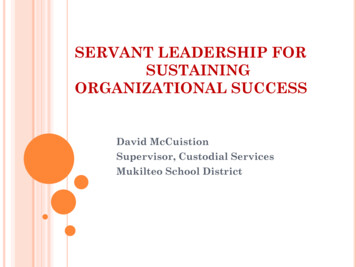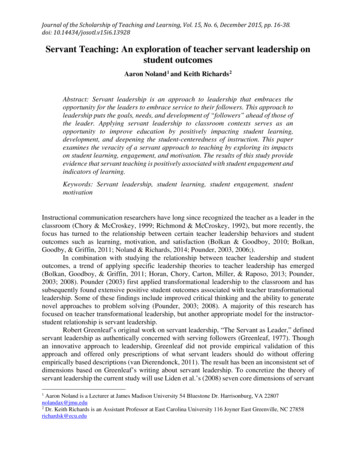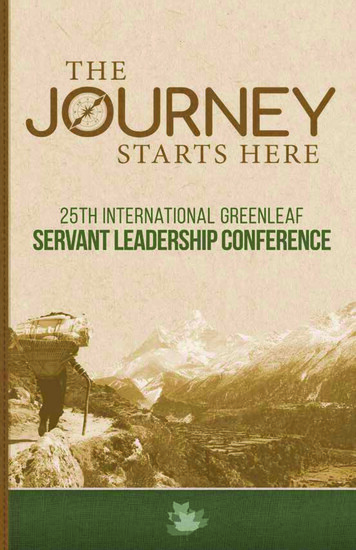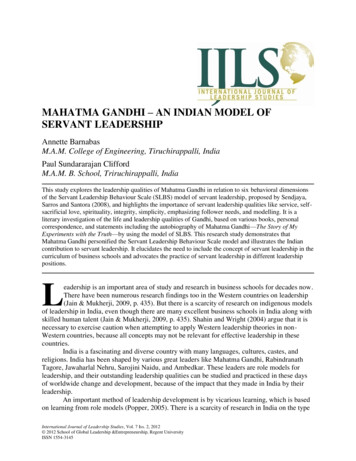
Transcription
SERVANT LEADERSHIP FORSUSTAININGORGANIZATIONAL SUCCESSDavid McCuistionSupervisor, Custodial ServicesMukilteo School District
OBJECTIVEAcquaint you with the origin and concept ofServant Leadership (SL) Who is the Servant Leader Identify The New Moral Principle & LeadershipModel Describe Characteristics of Servant Leadership Identify Practitioners of Servant Leadership Answer questions you might have
MY VISION FOR YOUDesire to learn more about Servant Leadership Desire to make a difference in the lives of those youlead Ultimately Create a Passion for Servant Leadership Desire to serve and not be served
WHAT SERVANT LEADERSHIP ISN’T Servile behavior Bowing down to others to get results Being the “Go-For” Forgiving actions to motivate the future Accepting poor performance
MODERN-DAY FOUNDER Dr. Robert K.Greenleaf (1904-1990) AT&T – 1926 to 1964AT&T Director ofManagement ResearchProfessorLecturerConsultant:
SERVANT LEADERSHIP EVOLUTION1964 – Founded Center for Applied Ethics, Inc. 1970 – “The Servant as Leader” Coined phrase “Servant Leadership” Launched modern SL movement 1985 – Robert K. Greenleaf Center Today – Greenleaf Center for Servant Leadershipin Westfield, Indiana WWW.greenleaf.org
SERVANT LEADERSHIP Essays and Reflections The Institution as ServantTrustees as ServantsServant Leadership in BusinessServant Leadership in EducationServant Leadership in FoundationsServant Leadership in Churcheswww.Regents.edu -- Search Servant Leadership
BEFORE GREENLEAF’S IDEA Plato (428 B.C. – 348 B.C.) Jesus Ruler seeks what is advantageous to subjects.I came to serve, not to be servedImmanuel Kant (1724 – 1804) Categorical ImperativeDoing the right thing Golden Rule John Stuart Mill (1806 – 1873) Utilitarianism – making life better for theorganization
GREENLIEAF’S ORIGIN OF THE IDEA Hermann Hesse’s “Journeyto the East”Band of Men on a mystical journey Central Figure – “Leo” Leo disappears and never re-appears Leo – Leader of “The League” – sponsor of journey The Law!
THE LAW OF SERVICEHe who wishes to live long must serve, but He who wishes to rule does not live long. Moral:Reward comes from serving others. Those who become leaders through endeavor, end innothing.
WHO IS THE SERVANT LEADER?Places the welfare of others before self Other people’s highest priority needs are beingserved Greenleaf’s “Best Test”: Do those served grow as persons? Do they become healthier, wiser, freer, moreautonomous? Are they more likely themselves to become servants?
NEW MORAL PRINCIPLE**Only authority deservingone’s allegiance Given freely andknowingly granted by theled to the leader Clearly evident in the“servant” stature of theleader. Proven and trusted asservants. **Larry C. Spears – Focus on Leadership: ServantLeadership for the 21st Century
NEW LEADERSHIP MODEL** Based on Teamwork and Community Seeks to involve others in decision making Strongly based on ethical and caring behaviorsEnhances the personal growth of workers whileimproving caring and quality of our many institutions.**Larry C. Spears – Focus on Leadership: Servant Leadership for the 21st Century
ARE YOU A SERVANT LEADER? Believe you are willing to sacrifice your own selfinterest for the good of the group?Believe you want to hear their ideas and willvalue them?Believe that you will understand what ishappening in their lives and how it affects them?Come to you when chips are down or somethingtraumatic has happened in their lives?Believe that you have a strong awareness forwhat is going on?
ARE YOU A SERVANT LEADER? Follow your requests because they want to orbecause they “have to?”Communicate their ideas and vision for theorganization when you are around?Have confidence in your ability to anticipate thefuture and its consequences?Believe you are preparing the organization tomake a positive difference in the world?Believe that you are committed to helping themdevelop and grow?Feel a strong sense of community in theorganization that you lead?
CHARACTERISTICS OF SLCalling Willing to sacrifice self-interest Natural desire to serve other Deeply rooted and value-based Make a difference in lives of others Actively pursue opportunities to impact others’lives Never for personal gain Sacrifice for the sake of others and their growth Without this “natural calling”, servant leadershipmay not be realistic or compatible style
CHARACTERISTICS OF SL Listening Deep commitment to listening intentlySeeks to identify the “will”, & help clarify that willReceptive to what “is” said, and what “is not” saidEncompasses getting in touch with one’s own “innervoice”Seeking to understand what one’s body, spirit, andmind are communicatingListening, coupled with regular periods of reflection,is essential to the growth of the servant leader
CHARACTERISTICS OF SL Empathy and Acceptance Strives to understand and empathize with othersPeople need to be accepted and recognized for theirspecial and unique spiritsAssumes the good intentions of coworkersAccept them as peopleRefusing to accept theirBehavior Performance Most successful Servant-leaders are those whohave become skilled empathetic listeners
CHARACTERISTICS OF SL Healing – “To make Whole”Powerful force for transformation and integration Great strength – healing oneself and others Broken spirits and emotional hurts To Servant Leader Great opportunity Motivation – To help make self whole
CHARACTERISTICS OF SLGreenleaf: “There is something subtlecommunicated to one who is being served and ledif, implicit in the compact between servant-leaderand led, is the understanding that the search forwholeness is something they share.”
CHARACTERISTICS OF SL Awareness (Spears) Being able to view most situations from a moreintegrated, holistic position. Awareness aids in understanding issues that involveethics and values. Strengthens the servant-leader.
CHARACTERISTICS OF SL Self-Awareness (Daniel Goleman)**Delphic Oracle – “Know thyself”. Having a deep understanding of one’s emotions,strengths, weaknesses, needs, and drives. Neither critical nor unrealistically hopeful Honest – with others and themselves How to Recognize it in oneself Candor; ability to assess oneself realisticallyAble to speak openly about emotionsFrank in admitting to failure – even smiling about itSelf-depreciating sense of humorSelf confidence**What Makes a Leader? Daniel Goleman – Contemporary Issues in Leadership
CHARACTERISTICS OF SL Self-Awareness (Goleman)** One of five components of Emotional IntelligenceEmotional Intelligence – Innate potential to feel,use, communicate, recognize, remember,describe, identify, learn from, manage,understand and explain emotions. (S. Hein 2007)Achievers – high emotional intelligence**What Makes a Leader? Daniel Goleman – Contemporary Issues in Leadership
CHARACTERISTICS OF SL PersuasionSL seeks to convince, rather than coerce compliance SL builds consensus within groups Relationship building skills Leadership by persuasion has the virtue of change byconvincement rather than coercion
CHARACTERISTICS OF SL ConceptualizationNurture their ability “to dream great dreams.” Clear vision of what others must do to grow andimprove. Nurture the idea of thinking beyond the day-to-dayview of problem solving. Seek assistance of other who might have morecreative abilities and skills.
CHARACTERISTICS OF SL ForesightEnables the SL to understand the lessons of the past, The realities of the present, and The likely consequence of a decision for the future. Foresight means:Regarding the events of the moment, Comparing with projections (experiences) of the past, At the same time projecting the future. Requires a lot of faith
CHARACTERISTICS OF SL Stewardship “Holding something in trust for another.” (Peter Block – Stewardship & The Empowered Manager)Commitment to serving the needs of others Improving them for the greater good of society Thomas Sergiovanni Moral Leadership: Getting to the Heart of SchoolImprovement Manage one’s life and affairs with proper regard forthe rights of other people for the common welfare Placing oneself in service to ideas and ideals and toother who are committed to their fulfillment.
CHARACTERISTICS OF SL Commitment to the growth of peopleSL believes people have intrinsic value SL recognizes a tremendous responsibility for thepersonal, professional and spiritual growth ofemployees. Possible actions:Professional Development Listening to suggestions Involve in decision making Moral & ethical development
CHARACTERISTICS OF SL Building CommunityInstitutions of today have lost that sense ofcommunity Institutions – not local communities – primaryshapers of human lives Servant Leader seeks to build a communitywithin the organization Greenleaf felt: Servant Leaders to show the way Demonstrate their own unlimited liability for aspecific community-related group of people
PRACTITIONERS OF SERVANT LEADERSHIPSouthwest Airlines – Employees come 1st. John Deere – Employee integrity & committment The Container Store -- #1 Stakeholder-Employees TDI Industries – one of the first practitioners USAA Insurance & Financial Services The White Dog Café – customers, community,earth, and serving each other. The Gore Company – Team-based, flat lattice,fosters personal initiative. Accountable to multidisciplined team members
PRACTITIONERS OF SERVANT LEADERSHIPServant Leadership as a Way of Life: TrinityWestern strives to teach and to embody thepattern of servant leadership exemplified byJesus Christ. Professors, administrators and students seek tomotivate and mobilize each other to think and actwith creativity, integrity, and skill for the benefitof all concerned.
PRACTITIONERS OF SERVANT LEADERSHIP Tony Dungy – Super Bowl winning Head Coach It’s all about ServicePrinciple focus must be beyond selfOther Directed Other Inspired Humble Servant LeadershipSee others as valuable Worth your time to serve them Timely, needed and right Tony asks, “What can you do in your organizationto “wash the feet” of the people you lead?
ETHICS OF LEADERSHIP Peter Drucker, in defining Business Ethics, says,“There is only one ethics, one set of rules ofmorality; one code, that of individual behavior inwhich the same rules apply to everyone alike.”He further states the rule for Business Ethics wasspelled out clearly, 2,500 years ago, in theHipprocratic oath of the Greek physician: primumnon nocere, “above all, not knowingly to do harm”that is the basic rule of professional ethics, thebasic rule of an ethics of public responsibility. The Daily Drucker: 366 Days of Insights and Motivation for Getting the Right Things Done
SUMMARIZERobert Greenleaf & Greenleaf Center Defined Servant Leadership Characteristics of Servant Leadership CallingListeningEmpathy & Acceptance Awareness & ghtCommitment to the Growth of PeopleBuilding CommunityStewardshipPractitioners of Servant Leadership
BIBLIOGRAPHYGreenleaf – “The Servant as Leader” Greenleaf – “The Institution as Servant” Hesse, H. – “The Journey to the East” “Focus on Leadership: Servant-Leadership forthe 21st Century Sergiovanni, T. – “Moral Leadership: Getting tothe Heart of School Improvement” NebGuide – U. Nebraska, Lincoln Extension “Contemporary Issues in Leadership” Tony Dungy – The Mentor Leader
THOUGHTS, QUESTIONS?
Greenleaf -"The Servant as Leader" Greenleaf -"The Institution as Servant" Hesse, H. -"The Journey to the East" "Focus on Leadership: Servant-Leadership for the 21st Century Sergiovanni, T. -"Moral Leadership: Getting to the Heart of School Improvement" NebGuide -U. Nebraska, Lincoln Extension










